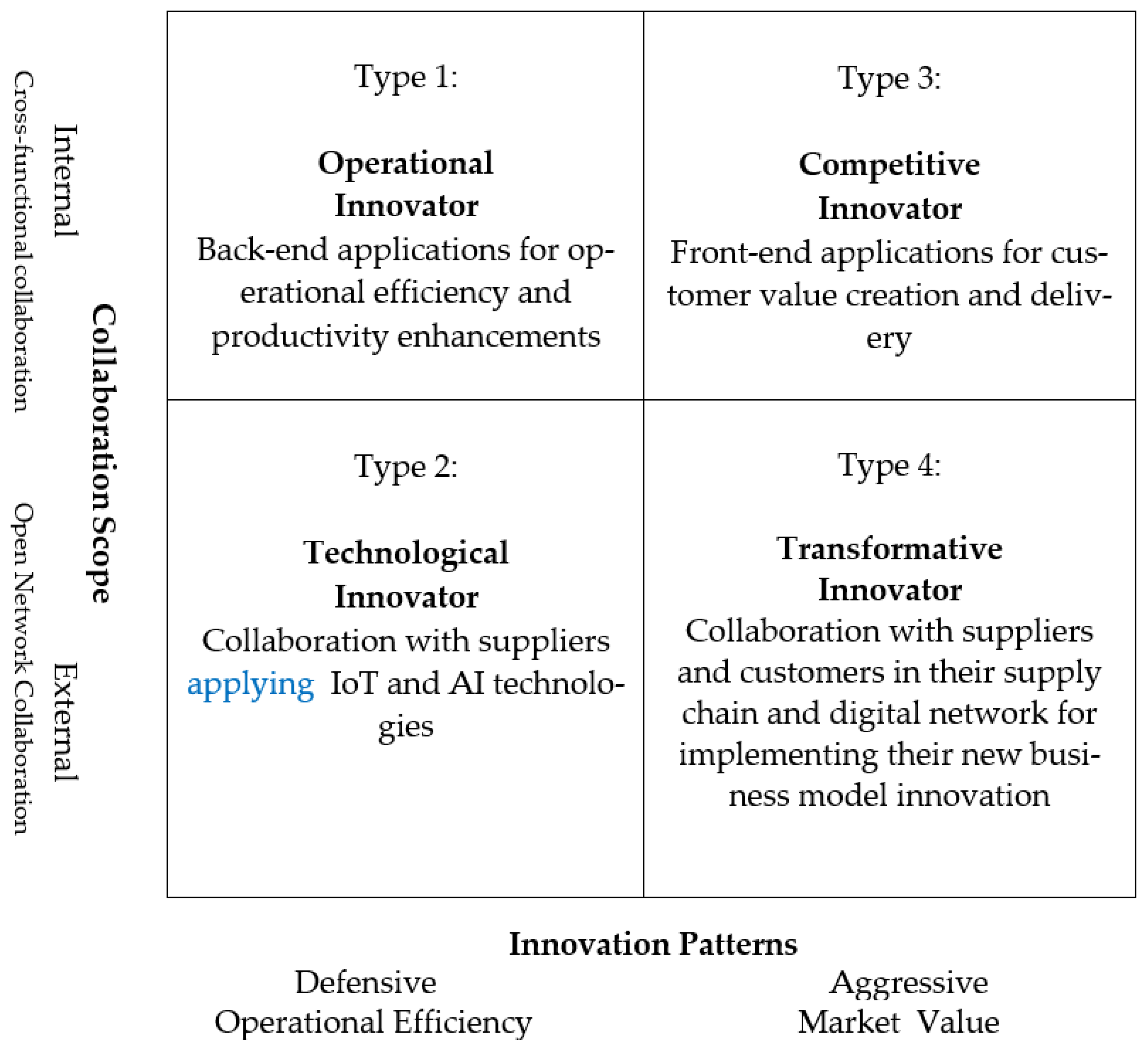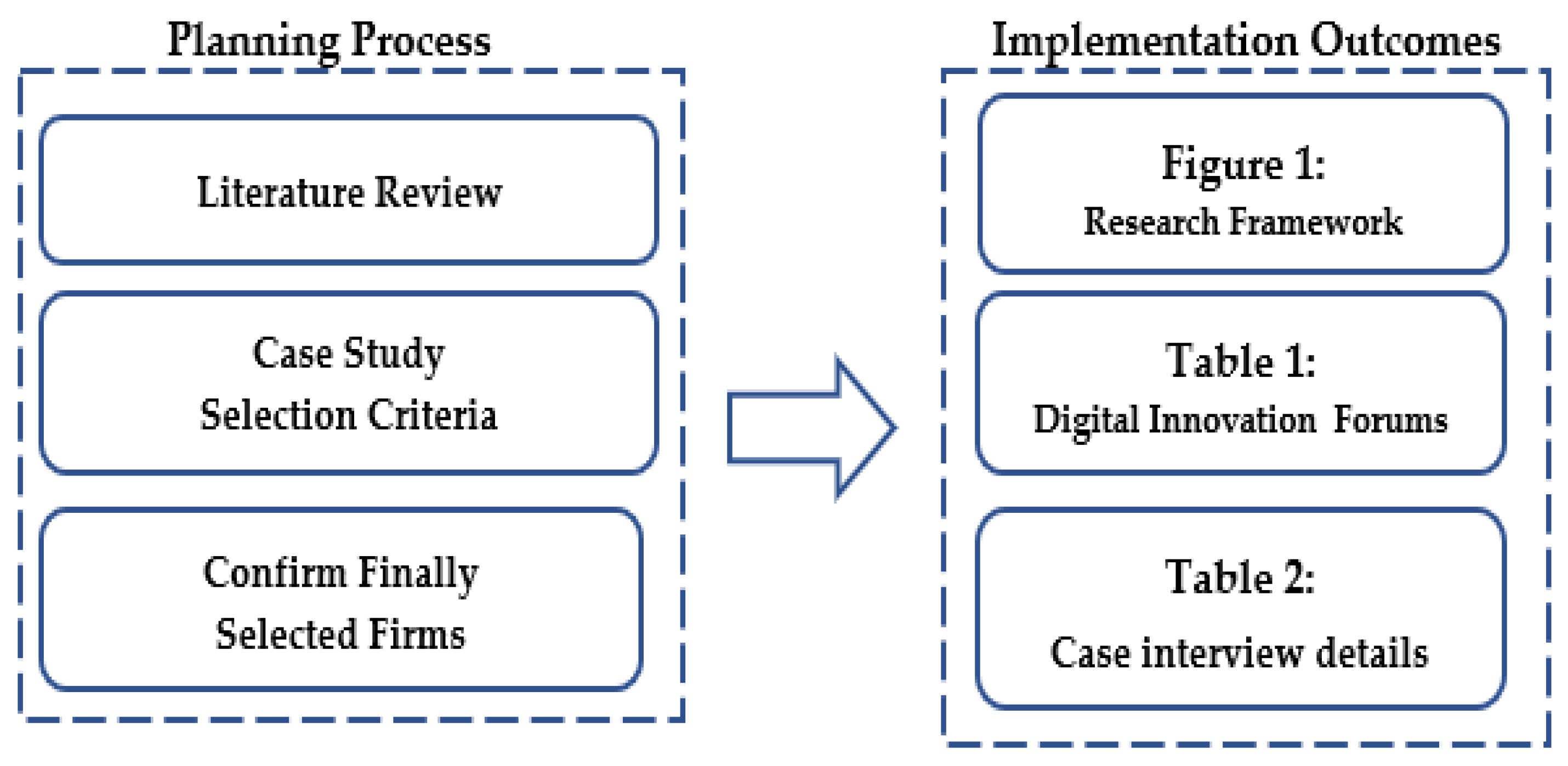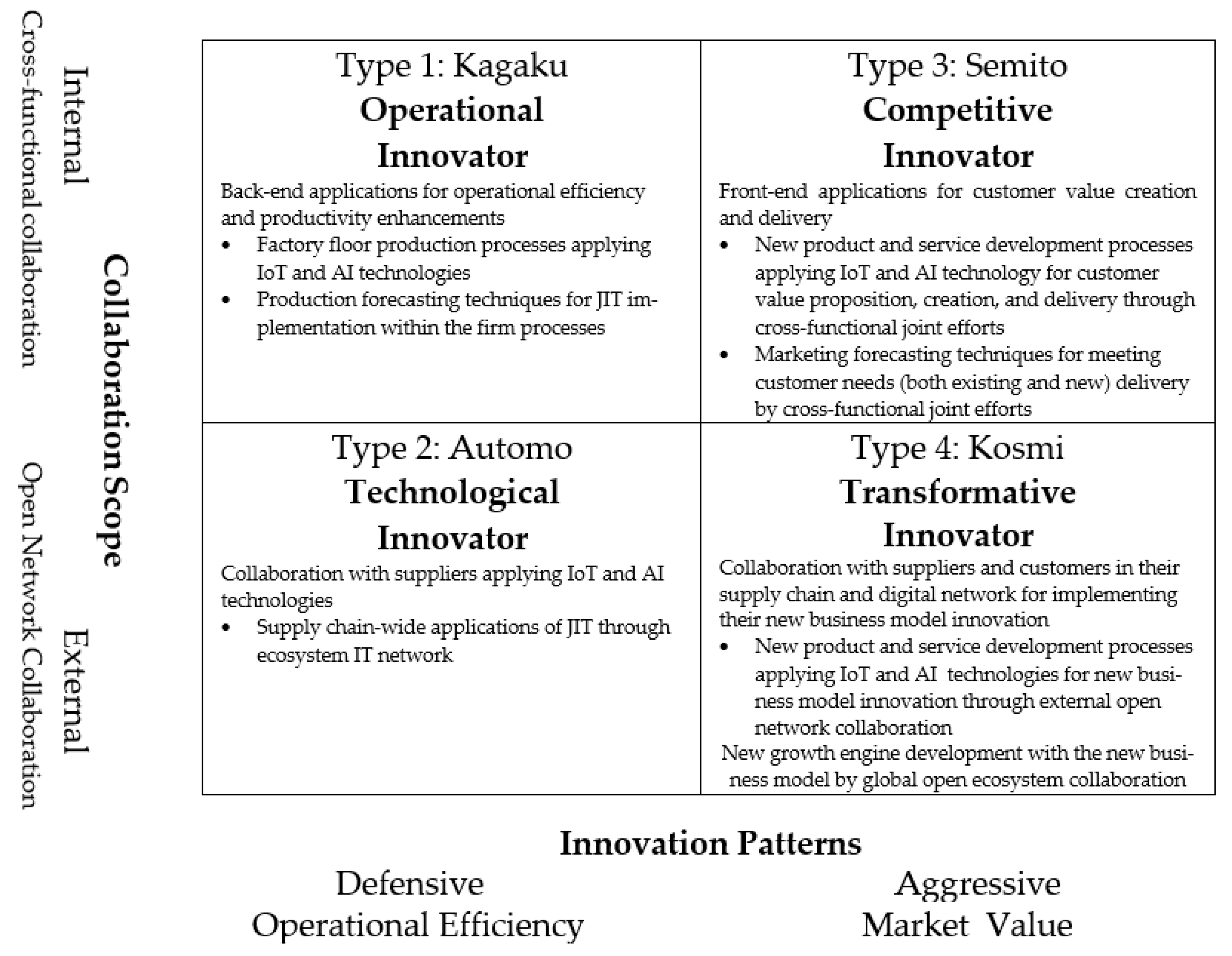A Research Framework for Sustainable Digital Innovation: Case Studies of Japanese Firms
Abstract
:1. Introduction
2. Supply Chain Integration for Sustainable Digital Innovation
2.1. Manufacturer–Supplier Integration
2.2. Customer Integration
2.3. Integrated Manufacturing Information System
2.4. Closed and Open Innovation for Two Aspects of Supply Chain Integration
2.5. Sustainable Digital Innovation through Ambidextrous Supply Chain Integration
3. A Research Framework
4. Research Methodology
4.1. Case Study Process
4.2. Organization of Research Projects: A Team of Researchers and Senior Managers from 26 Firms
4.3. Profiles of Four Firms
5. Case Analysis and Findings
5.1. Kagaku
5.2. Automo
5.3. Semito
5.4. Kosmi
5.5. Comparison of Cases
6. Conclusions and Discussion
6.1. Theoretical Implications
6.2. Managerial Implications
6.3. Future Research
Author Contributions
Funding
Institutional Review Board Statement
Informed Consent Statement
Data Availability Statement
Conflicts of Interest
References
- Boons, F.; Montalvo, C.; Quist, J.; Wagner, M. Sustainable innovation, business models and economic performance: An overview. J. Clean. Prod. 2013, 45, 1–8. [Google Scholar] [CrossRef]
- Yoo, Y.; Hendfridsson, O.; Lyytinen, K. The new organizing logic of Digital Innovation. An Agenda Information System Research. Inf. Syst. Res. 2010, 21, 724–735. [Google Scholar] [CrossRef]
- Kusi-Sarpong, S.; Gupta, H.; Sarkis, J. A supply chain sustainability innovation framework and evaluation methodology. Int. J. Prod. Res. 2019, 57, 1990–2008. [Google Scholar] [CrossRef] [Green Version]
- Bican, P.M.; Brem, A. Digital business model, digital transformation, digital entrepreneurship: Is there a sustainable “digital”? Sustainability 2020, 12, 5239. [Google Scholar] [CrossRef]
- Chen, J.; Zhang, R.; Wu, D. Equipment Maintenance Business Model Innovation for Sustainable Competitive Advantage in the Digitalization Context: Connotation, Types, and Measuring. Sustainability 2018, 10, 3970. [Google Scholar] [CrossRef] [Green Version]
- Ciriello, R.; Richter, A.; Schwabe, G. Digital Innovation. Bus. Inf. Syst. Eng. 2018, 60, 563–569. [Google Scholar] [CrossRef]
- De Vass, T.; Shee, H.; Miah, S.J. The effect of “Internet of Things” on supply chain integration and performance: An organizational capability perspective. Australis. J. Inf. Syst. 2018, 22, 1–29. [Google Scholar] [CrossRef] [Green Version]
- Helfat, C.E.; Raubitschek, R.S. Dynamic and integrative capabilities for profiting from innovation in digital platform-based ecosystems. Res. Policy 2018, 47, 1391–1399. [Google Scholar] [CrossRef]
- Hess, T.; Matt, C.; Benlian, A.; Wiesböck, F. Options for formulating a digital transformation strategy. MIS Q. Exec. 2016, 15, 123–139. [Google Scholar]
- Kohli, R.; Melville, N.P. Digital innovation: A review and synthesis. Inf. Syst. J. 2019, 29, 200–223. [Google Scholar] [CrossRef] [Green Version]
- Legenvre, H.; Henke, M.; Ruile, H. Making sense of the impact of the internet of things on Purchasing and Supply Management: A tension perspective. J. Purch. Supply Manag. 2020, 26, 100596. [Google Scholar] [CrossRef]
- Schallmo, D.; Williams, C.A.; Boardman, L. Digital Transformation of Business Models—Best Practice, Enablers, and Roadmap. Int. J. Innov. Manag. 2017, 21, 1740014. [Google Scholar] [CrossRef] [Green Version]
- Nylén, D.; Holmström, J. Digital innovation strategy: A framework for diagnosing and improving digital product and service innovation. Bus. Horiz. 2015, 58, 57–67. [Google Scholar] [CrossRef] [Green Version]
- Yousaf, Z.; Radulescu, M.; Sinisi, C.I.; Serbanescu, L.; Păunescu, L.M. Towards Sustainable Digital Innovation of SMEs from the Developing Countries in the Context of the Digital Economy and Frugal Environment. Sustainability 2021, 13, 5715. [Google Scholar] [CrossRef]
- Nambisan, S.; Lyytinen, K.; Majchrzak, A.; Song, M. Digital innovation management: Reinventing innovation management research in a digital world. MIS Q. 2017, 41, 223–238. [Google Scholar] [CrossRef]
- Tang, M.; Liao, H.; Wan, Z.; Herrera-Viedma, E.; Rosen, M.A. Ten years of sustainability (2009 to 2018): A bibliometric overview. Sustainability 2018, 10, 1655. [Google Scholar] [CrossRef]
- Van Wassenhove, L.N. Sustainable innovation: Pushing the boundaries of traditional operations management. Prod. Oper. Manag. 2019, 28, 2930–2945. [Google Scholar] [CrossRef]
- Braunscheidel, M.J.; Suresh, N.C. The organizational antecedents of a firm’s supply chain agility for risk mitigation and response. J. Oper. Manag. 2009, 27, 119–140. [Google Scholar] [CrossRef]
- Liu, S.; Chan, F.T.; Yang, J.; Niu, B. Understanding the effect of cloud computing on organizational agility: An empirical examination. Int. J. Inf. Manag. 2018, 43, 98–111. [Google Scholar] [CrossRef]
- Puriwat, W.; Hoonsopon, D. Cultivating product innovation performance through creativity: The impact of organizational agility and flexibility under technological turbulence. J. Manuf. Technol. Manag. 2022, 33, 741–762. [Google Scholar] [CrossRef]
- Cheng, C.; Yang, M. Creative process engagement and new product performance: The role of new product development speed and leadership encouragement of creativity. J. Bus. Res. 2019, 99, 215–225. [Google Scholar] [CrossRef]
- Ferreira, J.; Coelho, A.; Moutinho, L. Dynamic capabilities, creativity and innovation capability and their impact on competitive advantage and firm performance: The moderating role of entrepreneurial orientation. Technovation 2020, 92, 102061. [Google Scholar] [CrossRef]
- Hong, P.; Park, Y.W. Rising Asia and American Hegemony: Practices of Global Firms from Japan, Korea, China and India; Springer: Singapore, 2020. [Google Scholar]
- Park, Y.W.; Hong, P.; Fujimoto, T. Literature survey field-based studies of supply chains robustness. MMRC Discuss. Pap. 2019, 510, 1–37. [Google Scholar]
- Sadeghi, R.; Taleizadeh, A.A.; Chan, F.T.; Heydari, J. Coordinating and pricing decisions in two competitive reverse supply chains with different channel structures. Int. J. Prod. Res. 2019, 57, 2601–2625. [Google Scholar] [CrossRef]
- Chan, H.L.; Shen, B.; Cai, Y. Quick response strategy with cleaner technology in a supply chain: Coordination and win-win situation analysis. Int. J. Prod. Res. 2018, 56, 3397–3408. [Google Scholar] [CrossRef] [Green Version]
- Zhang, Y.; Swaminathan, J.M. Warehouse Location in An Emerging Country: A Win–Win Proposition? Prod. Oper. Manag. 2020, 29, 1487–1505. [Google Scholar] [CrossRef]
- Chopra, S.; Sodhi, M. Reducing the risk of supply chain disruptions. MIT Sloan Manag. Rev. 2014, 55, 72–80. [Google Scholar]
- Fujimoto, T. A note on global supply chains in the after-COVID-19 Era. MMRC Discuss. Pap. 2020, 530, 1–15. [Google Scholar]
- Fujimoto, T. Supply chain competitiveness and robustness: A lesson from the 2011 Tohoku Earthquake and virtual dualization. MMRC Discuss. Pap. 2011, 354, 1–27. [Google Scholar]
- Fujimoto, T.; Park, Y.W. Balancing supply chain competitiveness and robustness through “virtual dual sourcing”: Lessons from the great east Japan earthquake. Int. J. Prod. Econ. 2014, 147, 429–436. [Google Scholar] [CrossRef]
- Oliver, J.J.; Parrett, E. Managing future uncertainty: Reevaluating the role of scenario planning. Bus. Horiz. 2018, 61, 339–352. [Google Scholar] [CrossRef]
- Wei, R.; Geiger, S.; Vize, R. Managing paradoxical tensions in platform-based modular solution networks. Industrial Mark. Manag. 2022, 100, 96–111. [Google Scholar] [CrossRef]
- Lam, J.S.L.; Gu, Y. A market-oriented approach for intermodal network optimisation meeting cost, time, and environmental requirements. Int. J. Prod. Econ. 2016, 171, 266–274. [Google Scholar] [CrossRef]
- Singh, N.; Hong, P. Impact of strategic and operational risk management practices on firm performance: An empirical investigation. Eur. Manag. J. 2020, 38, 723–735. [Google Scholar] [CrossRef]
- Zhao, K.; Zuo, Z.; Blackhurst, J.V. Modelling supply chain adaptation for disruptions: An empirically grounded complex adaptive systems approach. J. Oper. Manag. 2019, 65, 190–212. [Google Scholar] [CrossRef]
- Migdadi, M.M. Knowledge management, customer relationship management and innovation capabilities. J. Bus. Ind. Mark. 2021, 36, 111–124. [Google Scholar] [CrossRef]
- Wynstra, F.; Spring, M.; Schoenherr, T. Service triads: A research agenda for buyer–supplier–customer triads in business services. J. Oper. Manag. 2015, 35, 1–20. [Google Scholar] [CrossRef] [Green Version]
- Chandler, J.D.; Lusch, R.F. Service systems: A broadened framework and research agenda on value propositions, engagement, and service experience. J. Serv. Res. 2015, 18, 6–22. [Google Scholar] [CrossRef]
- Jagani, S.; Hong, P. Sustainability orientation, byproduct management and business performance: An empirical investigation. J. Clean. Prod. 2022, 357, 131707. [Google Scholar] [CrossRef]
- Fujimoto, T. Competing to Be Really, Really Good: The Behind-The-Scenes Drama of Capability-Building Competition in the Automobile Industry; I-House Press: Tokyo, Japan, 2007. [Google Scholar]
- Park, Y.W. Business Architecture Strategy and Platform-Based Ecosystems; Springer: Singapore, 2018. [Google Scholar]
- Park, Y.W.; Hong, P. Building Network Capabilities in Turbulent Competitive Environments: Practices of Global Firms from Korea and Japan; CRC Press: Boca Raton, FL, USA, 2012. [Google Scholar]
- Chang, Y.; Iakovou, E.; Shi, W. Blockchain in global supply chains and cross border trade: A critical synthesis of the state-of-the-art, challenges and opportunities. Int. J. Prod. Res. 2020, 58, 2082–2099. [Google Scholar] [CrossRef] [Green Version]
- Park, Y.W.; Hong, P.; Park, Y.S. Product architecture and integrated manufacturing information system: A comparative study of Japanese and Korean firms. Int. J. Bus. Excell. 2012, 5, 485–501. [Google Scholar] [CrossRef]
- Scuotto, V.; Arrigo, E.; Candelo, E.; Nicotra, M. Ambidextrous innovation orientation effected by the digital transformation. Bus. Process. Manag. J. 2019, 26, 1121–1140. [Google Scholar] [CrossRef]
- Gassmann, O.; Enkel, E.; Chesbrough, H. The future of open innovation. R Manag. 2010, 40, 213–221. [Google Scholar] [CrossRef]
- Huizingh, E.K. Open innovation: State of the art and future perspectives. Technovation 2011, 31, 2–9. [Google Scholar] [CrossRef]
- West, J.; Bogers, M. Leveraging external sources of innovation: A review of research on open innovation. J. Prod. Innov. Manag. 2014, 31, 814–831. [Google Scholar] [CrossRef]
- West, J.; Salter, A.; Vanhaverbeke, W.; Chesbrough, H. Open innovation: The next decade. Res. Policy 2014, 43, 805–811. [Google Scholar] [CrossRef]
- Shih, W.; Hong, P.; Park, Y.W. Komatsu Komtrax: Asset Tracking Meets Demand Forecasting. Harvard Business School. 2018, pp. 1–16. Available online: https://www.hbs.edu/faculty/Pages/item.aspx?num=55304 (accessed on 20 June 2022).
- Yin, R.K. Case Study Research and Applications: Design and Methods; Sage Publications: New York City, NY, USA, 2017. [Google Scholar]
- Tabrizi, B.; Lam, E.; Girard, K.; Irvin, V. Digital transformation is not about technology. Harv. Bus. Rev. 2019, 13, 1–6. [Google Scholar]
- Morgan-Thomas, A.; Dessart, L.; Veloutsou, C. Digital ecosystem and consumer engagement: A socio-technical perspective. J. Bus. Res. 2020, 121, 713–723. [Google Scholar] [CrossRef]
- Nader, J.; El-Khalil, R.; Nassar, E.; Hong, P. Pandemic planning, sustainability practices, and organizational performance: An empirical investigation of global manufacturing firms. Int. J. Prod. Econ. 2022, 246, 108419. [Google Scholar] [CrossRef]
- Shih, W. Global supply chains in a post-pandemic world. Harv. Bus. Rev. 2020, 98, 82–89. [Google Scholar]
- Fukuzawa, M.; Sugie, R.; Park, Y.; Shi, J. An Exploratory Case Study on the Metrics and Performance of IoT Investment in Japanese Manufacturing Firms. Sustainability 2022, 14, 2708. [Google Scholar] [CrossRef]



| Organizers | 2020–2021 | Outcomes |
|---|---|---|
|
|
|
| Type | Type 1 | Type 2 | Type 3 | Type 4 |
|---|---|---|---|---|
| DX Project Presentation Firms | 7 Firms (Kagaku, FJ, OH, SM, LX, MP, YH) | 1 Firm (Automo) | 2 Firms (Semito, BN) | 2 Firms (Kosmi, OT) |
| Percentage | 58% | 8% | 17% | 17% |
| Selected Firm | Kagaku | Automo | Semito | Kosmi |
| Category | Chemical Device | Battery Device | Vacuum Device | Cosmetics |
| Firm Description | Chemical materials, medical devices, and camera | Automotive parts and electronic components Battery device firm | Automation- related products | Japanese cosmetics |
| Project leader | Director of DX innovation | Director of IT system | Director of Engineering Design | Director of R&D Center |
Publisher’s Note: MDPI stays neutral with regard to jurisdictional claims in published maps and institutional affiliations. |
© 2022 by the authors. Licensee MDPI, Basel, Switzerland. This article is an open access article distributed under the terms and conditions of the Creative Commons Attribution (CC BY) license (https://creativecommons.org/licenses/by/4.0/).
Share and Cite
Park, Y.W.; Hong, P. A Research Framework for Sustainable Digital Innovation: Case Studies of Japanese Firms. Sustainability 2022, 14, 9218. https://doi.org/10.3390/su14159218
Park YW, Hong P. A Research Framework for Sustainable Digital Innovation: Case Studies of Japanese Firms. Sustainability. 2022; 14(15):9218. https://doi.org/10.3390/su14159218
Chicago/Turabian StylePark, Young Won, and Paul Hong. 2022. "A Research Framework for Sustainable Digital Innovation: Case Studies of Japanese Firms" Sustainability 14, no. 15: 9218. https://doi.org/10.3390/su14159218
APA StylePark, Y. W., & Hong, P. (2022). A Research Framework for Sustainable Digital Innovation: Case Studies of Japanese Firms. Sustainability, 14(15), 9218. https://doi.org/10.3390/su14159218







